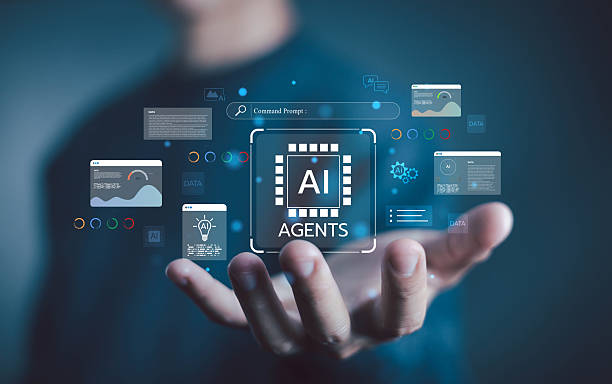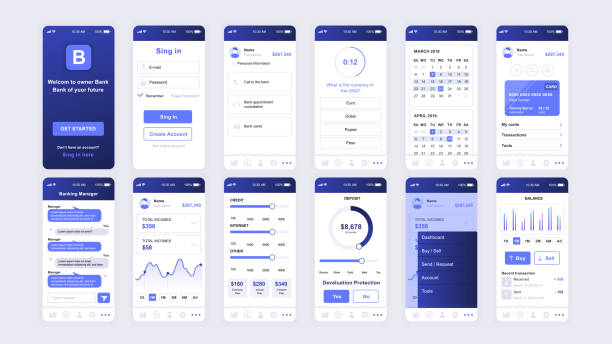## 💡 An Introduction to Building an AI Agent for Competitor Analysis
Okay, let’s dive into a fascinating and practical topic: building an AI agent for competitor analysis. Why should we even consider building something like this? The answer is simple: In today’s highly competitive world, having an intelligent assistant that can monitor competitors and provide valuable information is a huge advantage. This way, we can devise better strategies and stay ahead of the competition. Imagine having software that constantly monitors your competitors’ activities and provides you with reports; wouldn’t that be great?
First of all, we need to know what an AI agent is and how it works. Simply put, an AI agent is a computer program that can perform specific tasks automatically. These tasks can include gathering information, analyzing data, making decisions, and even making predictions. Now, when we design this agent for competitor analysis, we are essentially teaching it how to analyze the behavior and performance of competitors and identify important patterns.
These agents can collect information from various sources, including competitor websites, social networks, news articles, and industry reports. After collecting the information, the agents use various algorithms to analyze the data. These algorithms can include machine learning techniques, natural language processing, and big data analytics. The goal of these analyses is to identify the strengths and weaknesses of competitors, their marketing and sales strategies, and market trends.
But why should we use an AI agent instead of doing these tasks ourselves? Well, there are several important reasons. First, agents can collect and analyze information much faster and more accurately than humans. Second, agents can work 24/7 without interruption. And third, agents can identify patterns that may be hidden from human eyes. So, if you want to succeed in today’s competitive market, building an AI agent for competitor analysis can be a smart investment.
🎯 Defining Goals and Requirements
Before we get started and begin building an AI agent, we need to take a step back and think a little. What exactly do we want this agent to do? What requirements do we have? These questions are very important because their answers will determine our path. For example, maybe our goal is to find out what products competitors are advertising. Or maybe we want to know what customers are saying about our competitors. The more precise our goal is, the better agent we can build.
The first step is to make a list of our goals. This list should include all the questions we want the agent to answer. For example:
Key Goals:
* Identify competitor pricing strategies
* Review customer feedback about competitors
* Find the keywords used by competitors in online advertising
* Identify popular competitor content on social media
After we have defined our goals, we need to determine the technical requirements. These requirements include the data sources that the agent needs access to, the machine learning algorithms it should use, and the technical infrastructure on which the agent should run. For example, we may need access to the social media API, or we may need to use a cloud service for data storage and processing.
Another important requirement is to define Key Performance Indicators (KPIs). These indicators will help us understand whether the agent is working well or not. For example, we can consider the amount of information collected, the accuracy of the analyses, and the speed of response as KPIs. After we have specified all these requirements, we can move on to the next steps with more confidence and start designing and implementing our AI agent. Remember that the better planning we have, the better our results will be.
Is your brand image shining online? Rasaweb Afarin ensures a positive and powerful image of your business with intelligent brand reputation management.
✅ Monitoring and responding to customer feedback
✅ Creating positive content and strengthening trust
✅ Dealing with potential crises and maintaining credibility
With us, maintain and strengthen your brand reputation!
🌐 Choosing the Right Data Sources
Choosing data sources is one of the most important steps in building an AI agent for competitor analysis. If the data sources we choose are not proper and accurate, our agent will not be able to provide accurate analyses. So we have to be very careful about what information we collect and from where. First of all, we need to think about exactly what kind of information we want to obtain. For example, do we want to know what advertising campaigns competitors are running? Or do we want to understand what customers are saying about their products?
After we have identified the type of information we need, we need to look for appropriate sources. These sources can include competitor websites, social networks, news articles, industry reports, and even customer reviews in forums and blogs. Each of these sources has its own advantages and disadvantages. For example, competitor websites usually provide accurate information about their products and services, but they may hide information about marketing strategies. Social networks are also an excellent source for gathering customer feedback, but they may also contain inaccurate or biased information.
One of the important challenges in choosing data sources is to make sure that the information we collect is reliable and credible. To do this, we need to pay attention to the source of the information and see if it is a credible source or not. We should also try to collect information from several different sources and compare them to ensure their accuracy. If the information we collect is of poor quality, our agent will not be able to provide accurate analyses and we may make wrong decisions. So, choosing the right data sources is a valuable investment that can help us stay ahead of our competitors.
Click here to preview your posts with PRO themes ››
| Data Source | Type of Information | Advantages | Disadvantages |
|---|---|---|---|
| Competitor Website | Product Information, Prices, News | Accurate and comprehensive | Strategic information may be hidden |
| Social Networks | Customer Feedback, Trends | Up-to-date and direct | Information may be inaccurate |
🤖 Designing the AI Agent Architecture
Designing the AI agent architecture is like drawing a blueprint for a building before building it. We need to know how the different parts of the agent work together and how information is exchanged between them. A good architecture can greatly increase the efficiency of the agent and enable it to provide more accurate analyses. First of all, we need to define an overall structure for the agent. This structure usually consists of several main sections: the data collection section, the data processing section, the data analysis section, and the reporting section. Each of these sections performs specific tasks and works together so that the agent can achieve its goals.
The data collection section is responsible for collecting information from various sources. This section can use APIs, web scrapers, and other data collection tools. After the information is collected, it is sent to the data processing section. The data processing section is responsible for cleaning, normalizing, and converting the data into a format that is suitable for analysis. This section can use various techniques such as natural language processing, removing duplicate data, and converting data to numerical formats. After the data is processed, it is sent to the data analysis section. This section is responsible for using machine learning algorithms and other analytical techniques to identify patterns and trends in the data. This section can use classification, clustering, and regression algorithms.
Finally, the reporting section is responsible for presenting the results of the analyses to the user. This section can use charts, tables, and other data visualization tools to present the results in an understandable and attractive way. In addition, we should also think about how the agent should interact with the user. Should the user be able to change the agent’s parameters? Should they be able to create custom reports? Designing a good user interface can greatly improve the user experience and make it easy for the user to use the agent.
🧰 Implementation and Development
Okay, now that everything is ready, it’s time to get started and begin building our AI agent. This stage is the implementation and development stage. First of all, we need to choose a suitable programming language. There are different programming languages for building AI agents, but some of them are more suitable for this task. Python is one of the most popular programming languages for AI because it has many libraries for machine learning and data processing. In addition to Python, other languages such as R, Java, and C++ can also be used for building AI agents.
After we have chosen the programming language, we need to start writing the code. This can be a bit time-consuming, but if we have good planning, we can make progress quickly. First of all, we need to implement the different parts of the agent. For example, we need to implement the data collection section, the data processing section, the data analysis section, and the reporting section separately. After all sections have been implemented, we need to combine them and make sure they work correctly.
One of the important challenges in the implementation stage is data management. Our agent needs to be able to collect, process, and store a large volume of data. To do this, we need to use appropriate tools and techniques. For example, we can use NoSQL databases to store unstructured data. We can also use cloud services for data processing. After we have implemented the agent, we need to test it and make sure it works correctly. This can include testing the different parts of the agent, testing the agent’s performance under different conditions, and testing the accuracy of the agent’s analyses. If we find a problem, we need to fix it and test again.
Are your Discovery Ads not reaching relevant audiences? With Rasaweb Afarin’s Discovery Ads, showcase your products and services at the right moments to users who are ready to discover, and increase your sales!
✅ Show ads in Google, YouTube, and Gmail feeds
✅ Smart targeting based on user interests and behavior
✅ Increase brand awareness and attract new customers at minimum cost
⚡️ With us, discovering your business will be easier than ever!
📊 Using Machine Learning Algorithms
Machine learning algorithms are the heart of our AI agent. These algorithms help the agent to learn from the data and identify important patterns. Without machine learning algorithms, our agent is just a simple computer program that cannot provide accurate analyses. There are different types of machine learning algorithms, each suitable for specific tasks. For example, classification algorithms are used to categorize data into different groups. Clustering algorithms are used to find similar groups in the data. And regression algorithms are used to predict numerical values.
To choose the right algorithm, we need to pay attention to the type of data we have and the goal we want to achieve. For example, if we want to divide customers into different groups, we can use clustering algorithms such as K-Means. If we want to predict how likely a customer is to buy a product, we can use regression algorithms such as logistic regression. One of the important challenges in using machine learning algorithms is to select the appropriate parameters for the algorithms. Each machine learning algorithm has a set of parameters that need to be set so that the algorithm works as well as possible. Choosing the right parameters can be a complex process, but by using various techniques such as grid search and Bayesian optimization, we can find the optimal parameters.
Click here to preview your posts with PRO themes ››
Another important challenge is to prevent overfitting. Overfitting occurs when the machine learning algorithm becomes too accustomed to the training data and cannot generalize well to new data. To prevent overfitting, we can use various techniques such as regularization and cross-validation. By using the appropriate machine learning algorithms and setting their parameters, we can build a powerful AI agent that can provide accurate and useful analyses.
🔍 Analyzing and Interpreting Results
After our AI agent has performed the analyses, it is time for the analysis and interpretation of the results. This stage is very important because if we cannot interpret the results correctly, we cannot make the right decisions. First of all, we need to pay attention to what the results of the analyses are. Has the agent been able to identify important patterns? Has it been able to find new trends? Has it been able to identify the strengths and weaknesses of competitors?
After we have understood what the results of the analyses are, we need to compare them with the goals we set at the beginning. Has the agent been able to achieve all of our goals? If not, why? Maybe we need to retrain the agent or add new data sources to it. One of the important challenges in analyzing and interpreting the results is to prevent bias. Bias occurs when the results of the analyses are influenced by our assumptions or beliefs. To prevent bias, we should try to interpret the results objectively and without any prejudice. We should also try to use diverse data sources to prevent bias in the data. Another important challenge is to distinguish real patterns from random patterns. Sometimes the agent may identify patterns that are actually just due to chance and do not have any special meaning. To distinguish real patterns from random patterns, we can use various statistical techniques such as hypothesis testing and analysis of variance.
In addition, we should also pay attention to how the results of the analyses can help us make better decisions. Do the results of the analyses show that we should change our marketing strategy? Do they show that we should invest in new products? Do they show that we should change our prices? By carefully analyzing and interpreting the results, we can make more informed decisions and stay ahead of our competitors. Remember that building an AI agent is only the first step; using its results correctly is what really makes a difference.
🛡️ Continuous Evaluation and Improvement
Okay, is building an AI agent finished? No! Not at all. Continuous evaluation and improvement is one of the most important parts of this process. The competitive world is always changing, so our agent must be able to keep up with these changes. If we abandon the agent and don’t check on it anymore, it may soon become obsolete and no longer be able to provide accurate analyses. First of all, we need to think about how we can evaluate the performance of the agent. Is the agent achieving the goals we set at the beginning? Are the analyses it provides accurate and reliable? To evaluate the performance of the agent, we can use Key Performance Indicators (KPIs). These indicators help us understand whether the agent is working well or not. For example, we can consider the amount of information collected, the accuracy of the analyses, and the speed of response as KPIs.
In addition, we should also pay attention to user feedback. Are users satisfied with the results of the analyses? Do they have suggestions for improving the agent? User feedback can provide us with valuable information and help us to improve the agent. After we have evaluated the performance of the agent, we need to think about how we can improve it. Do we need to change the machine learning algorithms? Do we need to add new data sources to the agent? Do we need to improve the agent’s user interface?
One way to improve the agent is to use Reinforcement Learning techniques. Reinforcement learning allows the agent to learn by interacting with the environment and improve its performance. For example, we can reward the agent if it provides accurate analyses and penalize it if it provides wrong analyses. By using reinforcement learning, the agent can optimize its performance over time and become a professional analyst.
| Key Performance Indicator (KPI) | Description | How to Evaluate |
|---|---|---|
| Amount of Information Collected | The number of data the agent collects | Calculate the amount of data in a specified time period |
| Accuracy of Analyses | The correctness of the analyses provided by the agent | Compare the results with real data and expert opinions |
🔒 Security and Privacy Considerations
In today’s world, security and privacy are no longer an option, they are a necessity. When we are building an AI agent that is supposed to collect and process a lot of information, we must be very careful that sensitive information does not fall into the wrong hands and that people’s privacy is protected. First of all, we need to think about how we can protect data from unauthorized access. Do we need to use encryption? Do we need to limit access to the data? Do we need to use firewalls and other security tools?
Click here to preview your posts with PRO themes ››
One way to protect data is to use Anonymization and Pseudonymization techniques. Anonymization means completely removing personal information from the data. Pseudonymization means replacing personal information with an alternative identifier. By using these techniques, we can prevent the disclosure of personal information. In addition, we should also pay attention to how we can protect data from cyber attacks. Do we need to use Intrusion Detection Systems? Do we need to use Intrusion Prevention Systems? Do we need to back up data regularly?
Another important security consideration is to comply with the laws and regulations regarding privacy. There are various laws around the world that regulate how personal information is collected, processed, and used. For example, the GDPR law in Europe and the CCPA law in California grant individuals many rights regarding their personal information. We need to make sure that our agent is compatible with all these laws and regulations. By adhering to security and privacy considerations, we can gain user trust and prevent legal problems.
Are you looking to expand the sales market for your products online? With Rasaweb Afarin’s Marketplace Marketing services, we place your products on large and reputable shopping platforms and dramatically increase your online sales with effective strategies!
✅ Effective presence in the most visited marketplaces
✅ Increased access to a wide range of customers
✅ Management and optimization of product sales
Collaborate with Rasaweb Afarin for more sales in the marketplace: 09124438174
🚀 The Future of Building AI Agents for Competitor Analysis
The future of building AI agents for competitor analysis is very bright and exciting. As technology advances, these agents will become more powerful and intelligent and will be able to provide more accurate and useful analyses. One of the important trends in the future is the use of Generative AI in building AI agents. Generative AI allows agents to generate content themselves. For example, an agent can produce analytical reports, articles, and even advertisements. This can help us to spend less time and money on content production. Another important trend is the use of the Internet of Things (IoT) in data collection. By using IoT devices, we can collect more information about customer behavior and competitor performance. This information can help us to perform more accurate analyses and make better decisions.
In addition, AI agents are expected to be able to cooperate with each other and share information in the future. This can help us to gain a more comprehensive view of the market and competitors. For example, one agent can collect information about prices and share it with another agent that collects information about customer feedback. By combining these two types of information, we can have a complete analysis of the market situation. Finally, AI agents are expected to be able to make decisions and take necessary actions automatically in the future. For example, an agent can automatically change prices or create new advertisements. This can help us to react faster to market changes and take advantage of new opportunities. Considering these trends, we can expect that AI agents will play a very important role in competitor analysis and business decision-making in the future.
| Question | Answer |
|---|---|
| What is an AI agent? | A computer program that can perform specific tasks automatically. |
| Why should we use an AI agent for competitor analysis? | Because it can collect and analyze information faster, more accurately, and 24/7. |
| What data sources are suitable for competitor analysis? | Competitor websites, social networks, news articles, and industry reports. |
| How can we protect data from unauthorized access? | By using encryption, limiting access to the data, and using firewalls. |
| How can we prevent bias in analyses? | By interpreting the results objectively and using diverse data sources. |
| What is Reinforcement Learning? | A technique that allows the agent to learn by interacting with the environment and improve its performance. |
| What is Generative AI? | A type of AI that can generate content itself. |
| What is the Internet of Things (IoT)? | A network of physical devices that can collect and exchange information. |
| Why is continuous evaluation and improvement of the agent important? | Because the competitive world is always changing and the agent must keep up with these changes. |
| What are Key Performance Indicators (KPIs)? | Indicators that help us evaluate the performance of the agent. |
And other services of Rasa Web Advertising Agency in the field of advertising
• Optimizing image loading speed
• Producing comparative product content
• Marketing via TikTok Live
• Running Lead Generation Campaigns
• Content strategy consulting for corporate blogs
And more than hundreds of other services in the field of internet advertising, advertising consulting and organizational solutions
Internet Advertising | Advertising Strategy | Advertorial
What sets you apart from the competition?
Rasawb Afarin enhances your competitive advantage by providing unique insights.
✅ Expert insights for exceptional decisions.
✉️ info@idiads.com
📱 09124438174
📞 02126406207
Address: Tehran, Mirdamad Street, next to the Central Bank, South Kazerun Alley, Ramin Alley No. 6













